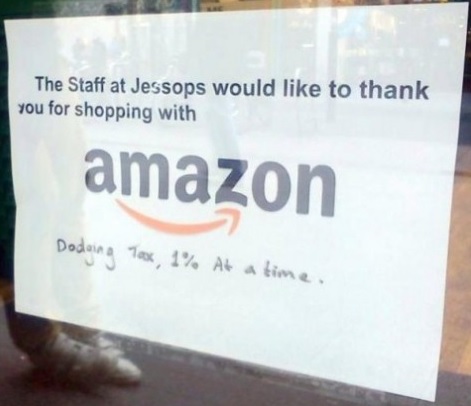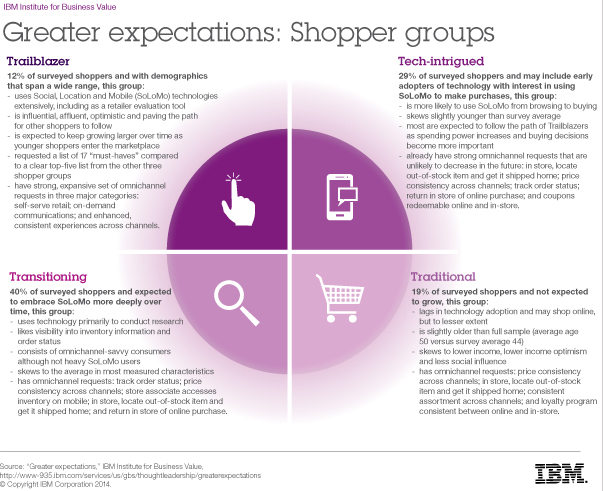Connecting “competing” online sales with shops-cum-showrooms
Ever-strengthening etailer sales are widely perceived to put shops under tough competitive pressure. However, the overall winners will be companies who successfully bridge the gap.

^ The bitter end: Ascribing defeat to etail |
Retailers know that not all shop visitors intend to make a purchase; half of Generation Y males and 70% of females regard shopping as a form of entertainment and quality time1. But a US study showed that while 7% of retail shoppers do not intend to buy the kind of product they were browsing for at all within 30 days, more; 9% had in mind to purchase online2. Aggressively boosting the rapid rise of etail, Amazon enhanced customers’ ability to “showroom” (use bricks-and-mortar shops for research) with the introduction of a price-checking app3.
So, how to solve the problem?
Much of the most recent thought-leadership suggest retailers can fight back, with showroom showdown tactics such as offering gift vouchers4, or simply dropping product prices on the spot5, even by 15-20%6. But competing with online on price doesn’t sound realistic, when shops’ overheads would seem to put them at disadvantage.
Findings from ForeSee suggests the figures aren’t as bad as they sound; while 70% of shoppers used their smartphones for product research alongside their visit, only 37% browsed competitors’ info, while 62% viewed the website or app of the retailer they were standing in7.
If the bookseller also owns an online store, they should seek to derive full compensation for offering that showrooming value. The real problem for brick-and-mortar stores is “offering no more value than a vending machine”8; sometimes known as an online store.
 Embracing change? Best Buy boldly strove to appropriate the term “showroom” to their advantage last Christmas; a move judged unwise9
Embracing change? Best Buy boldly strove to appropriate the term “showroom” to their advantage last Christmas; a move judged unwise9
A Business Insider Intelligence report on showrooming concludes that there’s no battle between off- and on-line: Retailers must offer the best overall shopping experience by leveraging the value added by physical stores10. Shops offer unique “discovery and atmospheric value”11 to the customer experience. Something is missing with online retail discovery.12; an opportunity for the possession said to be nine tenths of a sale. So: How to glean returns for this value-add?13.
We need realistic, friendly, creative, open-minded, tangible ways to recoup the value already supplied in-store. If shoppers appreciate the opportunity to browse products in real-life before buying, that vendor is already winning brand loyalty. Shop staff – lest we begin to regard them an unnecessary expense in the sales process – naturally ask visitors what they are looking for and could make a point of ultimately asking if they weren’t able to find a suitable item. If not, there is the opportunity to present relevant vouchers for their online store. Then, we could begin to talk about not only sales lost to a competitor’s – but gained through your – e-store. This would also allow the vendor to analyse the correlation with vouchers being redeemed online to understand the value the shop and its staff provide as a showroom – hopefully now in a positive sense – to the sales process. If retailers feel they are losing customers in-store to online, it’s because thus far we leave the matter at letting the customer leave the store.
There are no doubt many more refined possibilities besides this hatchling example. Reasonably sophisticated capabilities of customer data interconnectivity and comprehensive customer data in consistent format would be required for this kind of idea — but such a faculty only represents a small part of a more ambitious stride in the evolution retail must undergo to keep up with customer demands. All retailers need to translate the holistic experience a customer wants into a holistic process the retailer can operate: “It is an experience that begins before customers enter the physical store and continues long after they leave.”14. Customers are empowered with unprecedented technology and their expectations are ever more demanding; they are “asking for tomorrow today.”15. But today’s unprecedented advanced data analytics technology allows retailers to exceed their expectations16.
A technology solution that allows fluent provision of customer data to different business units offers limitless possibilities for maximising customer engagement (bringing additional customer insight to the informative value of automated, accurate sales reporting). Retailers who connect their off- and online business offerings create an opportunity to garner further data about customer behaviour. Data is power17 — and in conjunction with predictive analytics lets vendors offer each customer what they are most likely to want at any time18, informing ongoing personalised marketing and customer experience that continually optimises sales.
To find out more about how we support integrated data flows to enhance retailers’ profits and reporting thereof — and augment this with leading predictive analytics technology to use your customer data to further boost sales, please contact us.
Endnotes
1. New Gen Y Shopping Preferences Revealed, TradeSmart
2. “Showrooming” Affecting U.S. Retail Sales, Gallup Economy
3. Price Check! Amazon App Takes Aim at Brick-and-Mortars, Bloomberg Businessweek
4. Marqueta’s Solution to the Showrooming Problem, Marqeta
5. Don’t Let ‘Showrooming’ Sabotage Your Shop, Bloomberg Businessweek
A sense of guilt costs nothing: See also Elliott Bay Book’s attempt to encourage customers to question their conscience; One Sure-Fire Way To Lose The Battle Against Showrooming
6. If customers find a 15-20% cheaper price elsewhere, the chance of leaving the store is 62%: Profile of a Showroomer and 40 Tips to Combat Showrooming, CrossCheck Inc referencing Showrooming: Offline Retail Challenge; Online Opportunity, ©2013 Anderson Robbins Research
7. ForeSee Mobile Satisfaction Index: Holiday Retail, ForeSee
8. Steve Deckert, Dear Best Buy, Target & Other Retailers: Showrooming Isn’t Your Problem, Sweet Tooth
9. Maybe Calling Itself A “Showroom” Isn’t The Best Holiday Marketing Plan For Best Buy, Consumerist and Best Buy’s Latest Holiday Ad: Gutsy, but So Naive, DailyFinance
10. The Mobile Showrooming Threat and How it is Changing the Retail Industry, Business Insider Intelligence
11. “Something is seriously missing with online retail discovery.” – Peter Hildick-Smith, founder and CEO of Codex, reporting their survey’s findings; Can Showrooming Actually Save Bookstores?, Publishing Perspectives
12. Ibid.
13. Chief Executive of HarperCollins, Victoria Barnsley, remarked it would be “not that insane” to charge a showrooming fee; The peril of ‘showrooming’, BBC News Magazine — A shop in Queensland has implemented this very policy, in the form of a deposit refunded upon purchase: Store charges $5[AUD] ‘showrooming’ fee to looky-loos, CNET. If this policy carries a risk of appearing unfriendly, even blunter are the measures of disallowing customers taking photos with smartphones and covering up barcodes (What Local Businesses Need to Know About Smartphone Shopping Apps, Neighborhood Notes (Portland community site) – Creativity can’t compromise customer care!
14. The Next Evolution: Store 3.0™: An executive perspective on retailer readiness for tomorrow’s store, Deloitte
15. Greater expectations: Consumers are asking for tomorrow – today [PDF, 20pp], IBM Institute for Business Value Global Consumer Study also finds that due to “Trailblazers’ taking advantage of the latest technology, showrooming will no longer be a problem in the future. (Executive summary [PDF, 4pp] also available).

16. Empowering the Modern Marketer: Helping you transform how you interact with customers, SAP ebook
Further reading:
Predictive Customer Intelligence: Meeting the needs of the “always on” consumer, IBM
17. Data is power, The Bookseller
18. How much can retailers benefit from customer data? Influential Software